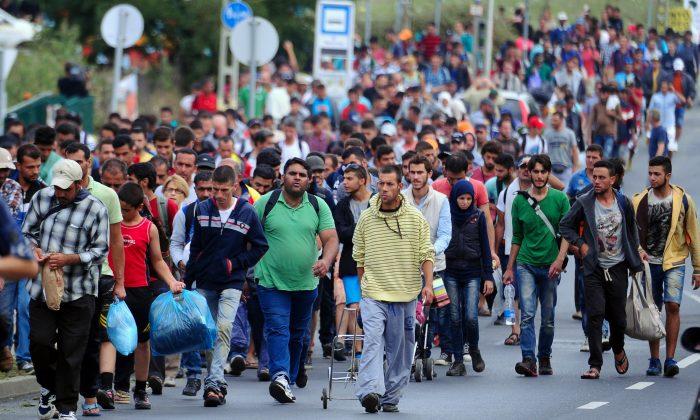LONDON—The Brick Lane Mosque in London’s East End started out 272 years ago as a church for Protestants hounded from Catholic France — the immigrants for whom the word “refugee” was first coined. Later, displaced eastern European Jews turned it into a synagogue. Today, Muslims pause in the lobby to kick off their shoes before answering the call to prayer.
That layering of migrating people and cultures over centuries, one wave settling over another like strata in rock, tells the story not just of London but of Europe itself.
The refugee tide so sorely testing the continent’s institutions and conscience is unquestionably a harrowing emergency, with flows of desperate people risking their lives to reach Europe on a scale unseen since World War II uprooted tens of millions.
But taking a longer, historical view, the Syrians, Iraqis, Afghans and others seeking sanctuary are simply following what has long been a European tradition. For centuries and for a spectrum of reasons, Europeans have had itchy feet, moving from one town to another, one country to another, one continent to another and, often, back again. European history’s soundtrack has played to the trample of feet. That heritage means modern Europeans aren’t as dissimilar as some think from asylum-seekers now reaching out for their help.
Over time, the perpetual motion has blended people, their ideas and technologies and helped to build Europe into the resilient, deeply textured, economically and culturally rich continent now so appealing to those seeking new lives.
Unlike Romans, Huns, Vikings, Moors, Normans, Nazis and other aggressors whose invasions left indelible marks, today’s newcomers aren’t coming to make war. Many are fleeing it, driven out by death, bombs and Islamic State terror. Others, driven by the human tendency to dream of a better life, want work and opportunity.
Similarly, Europe’s travelers have over centuries covered the broadest possible range, from intrepid medieval merchants like Marco Polo to today’s twentysomethings who grew up as the continent legislated away internal borders. This generation hops aboard low-cost flights from one European capital to another — sometimes on a whim or to attend a football match, sometimes for more life-changing reasons like love or a job.
From Europe’s western shores to the expanses of Russia where Napoleon and Adolf Hitler’s troops foundered, the marks of migration remain visible like footsteps in snow. The Kremlin, for example, resembles the Sforza Castle in Milan because Italian builder Pietro Antonio Solari — having made what was then a grueling trip from the Italian city to Moscow — had a major hand in rebuilding the fortress in the late 15th century. And it was a Scottish architect and clockmaker, Christopher Galloway, who remodeled the Savior Tower that leads to Red Square.
In the heart of Europe, Viennese cooked on open fires before Italian Renaissance architects introduced them to chimneys, spawning a whole new industry — chimney-sweeping — which Italians and Italian-speaking Swiss built up, migrating with their families to what became the capital of the Austro-Hungarian Empire, said Annemarie Steidl, a University of Vienna expert on migration.
“There are still chimney sweeps in Vienna, if you look in the phone book, who can trace their ancestors back to these Swiss-Italians,” she said. “It’s the story of Europe ... One group after another arriving, blending in and changing our society.”
What exactly the latest newcomers will contribute and how isn’t yet written. That will depend, in part, on how and where they set up new lives, and how they and their hosts adapt to each other. Like waves of settlers before them, they will have to contend with fears that they'll take away jobs, housing and resources from people already established. In return, by putting down new roots, they and their offspring will add new strands to Europe’s tapestry.
“Each time there was an intense resistance and a notion that ‘You don’t belong here, you’re invading us,’” says Columbia University sociologist Saskia Sassen, author of “Guests and Aliens,” which analyzes the history of migration and refugees. “And then they become incorporated and build one of the layers.”
Assimilation isn’t a given. Race riots in the 1950s in England, mobs chasing African immigrants through streets of southern Spain in 2000 and immigrants’ children torching cars in a three-week orgy of rioting in France in 2005 showed that the process can be spectacularly fraught and violent.
Even outsiders who are culturally and ethnically similar to their hosts have long triggered reactions of suspicion, hatred, even murder. In 1893, rampaging mobs of Frenchmen killed and injured dozens of Italian laborers working the salt flats of southern France’s Camargue region. After crossing the English Channel in the tens of thousands to escape France’s King Louis XIV in the 17th century, Huguenot Protestants — the original “refugees” — were welcomed by some in Britain but eyed warily by others.
The same was true when Czech-speaking migrants flooded into fast-expanding imperial Vienna for work, making up one-quarter of its population by the end of the 19th century, said Steidl.
“People were afraid of these newcomers, because they were different,” she said. “Nowadays, they are completely blended in.
“It took two or three generations before these people were part of our society.”
Given time, that process will also work with the migration testing Europe now, Steidl predicted.
“These people will be European. But Europe will be different,” she said. “Migrants are changing us and we are changing the migrants.”
With Indian parents and an English spirit, Sunny Bhopal embodies that idea. Having moved from Punjab state in northern India to England in 1975, his grandfather started the fabric store, piled from floor to ceiling with hundreds of rolls of cloth, where Sunny works with his mother, Malkit. The Brick Lane Mosque is across the street.
Born in London, 27-year-old Sunny roots for India when its team plays cricket against England (which, incidentally, picked three British-born Asians in its squad taking on Pakistan this month). Sunny speaks Punjabi with his mother, whose English, by her own admission, remains patchy despite 35 years in England.
But when Sunny travels to India to see family, he said, “I feel more English.”
“I don’t feel like it’s the place for me. I can’t take the heat,” he said. “For me, home is actually back in England.”
France’s Barcelona-born prime minister, Manuel Valls, and Paris Mayor Anne Hidalgo, who spoke not a word of French when she moved with her parents from Spain at age 2, also stand out as examples of how quick integration can be, and of the energy migrants can bring with their desire to succeed.
On the northern outskirts of Paris, the once large and distinct community of Spanish migrants who came to work the factories is also melting into the mainstream. In what used to be known as “Little Spain,” the bell on the chapel that catered to them is now silent and their theater is closed. They still have a cultural center, just a short walk from the national stadium where France’s most famous immigrant son, Zinedine Zidane, scored World Cup-winning goals in 1998. Speaking Spanish together despite their decades living in France, gray-haired retirees meet at the center in the afternoons, sitting four to a table with Spanish decks of cards.
Once they are gone, the center might go with them, because their France-born kids won’t feel the same attachment to this Spanish home away from home.
“It won’t be a focal point of their life as it is with the first generation,” said Gabriel Gaso, director of the FACEEF, an umbrella group of Spanish associations in France. “One day or another it will disappear altogether, if there isn’t a new wave of large-scale immigration.”
The Syrians, Iraqis and other newcomers are now embarking on this journey, with their new hosts. They’ve met on the one hand with outpourings of help from ordinary Europeans and on the other with a razor-wire fence in Hungary, police tear gas and the country’s prime minister, Viktor Orban, declaring: “If we let everybody in, it’s going to destroy Europe.”
The parallels between past and present are striking.
“The fact that some people want to open their hearts and their homes to refugees who have gone through so much and the fact that others want to say ‘It’s too many all at once,’ or that others will say ‘Well, they’re a swarm, they’re a plague, they’re nothing do with us’ ... We’ve heard all that 300 years ago for Huguenot refugees fleeing from persecution, we’ve heard it down the ages, and we’re hearing exactly that complex mixture of different attitudes today,” said Susie Symes, chair of trustees of Britain’s Museum of Immigration and Diversity, housed in a former Huguenot home in London’s Spitalfields district.
“One of the difficulties, even in this globalized media age, is that many people know so little about what people are going through and they don’t feel able to put themselves in somebody else’s shoes,” she said. “They don’t learn and show that empathy. They see this as something that could never happen to them.”
Yet the footsteps left by migration show that Europeans’ lives and their continent would be very different, certainly poorer, had people stayed rooted to the spot. Had their ancestors not left Ireland, the Beatles might not have met in Liverpool, one of the great European ports that for centuries have shipped people, ideas and other treasures in and out. Albert Einstein might not have become a Nobel prize-winning physicist had he stayed in Ulm, Germany, where he was born in 1879. His migratory path of schooling and discovery took him to Munich, Italy, Switzerland, back to Germany and finally to the United States.
Had migrants from former colonies not given them a taste for spice, Britons likely wouldn’t now consider curry a national dish. And had Ludwig Kazmierczak, the paternal grandfather of Angela Merkel, not moved to Berlin from what is now Poland, would she have become Germany’s chancellor and been so sympathetic to those now washing up on Europe’s shores? Nicolas Sarkozy certainly wouldn’t have become France’s president from 2007-2012 had his father, Pal Sarkozy, not fled to Paris from his native Hungary at age 20, to escape military service in Soviet Russia.
With time and industry, the Huguenots repaid England’s welcome by enriching it with their business acumen and skills, notably silk-weaving. And as they melted into English society, their church began its transformation into a metaphor for human layering, becoming a Methodist chapel, the Great Synagogue and now the mosque with its chimney-like shiny metallic minaret.
“Imagine London without its great tradition of welcoming strangers who have always proven, ultimately, to be a huge benefit,” said historian Dan Cruickshank. “London without that would be a bleak and sad provincial place.”





